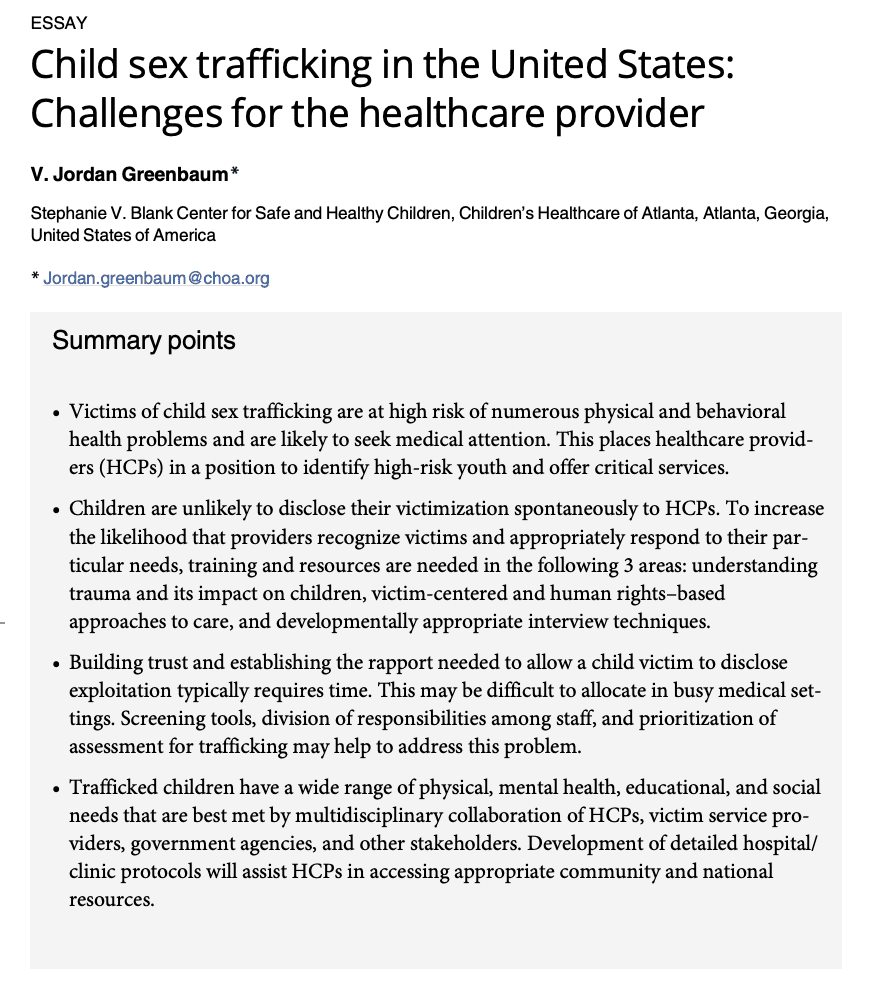
Child sex trafficking in the United States: Challenges for the healthcare provider
Scope and definition of child trafficking
Human trafficking violates fundamental human rights of children the world over. In a global study by the United Nations, identified trafficked persons originated from 106 countries. Of over 17,000 victims, 28% were children, with girls outnumbering boys by a factor of 2.5. According to United States federal law, sex trafficking involves “The recruitment, harboring, transportation, provision, obtaining, soliciting or patronizing of a person for the purpose of a commercial sex act (any sex act on account of which anything of value is given to or received by any person) using force, fraud, or coercion, OR involving a child less than 18 years of age.” This definition is broad relative to many countries, as it does not require transporting a victim, and it does include commercial sexual transactions between a child and another person that do not involve a third party controller (sometimes referred to as “survival sex” when applied to the homeless/runaway population). Thus, child sex trafficking (CST) includes using a minor to produce child sexual exploitation materials (“pornography”), using a child in a sex-oriented business (e.g., exotic dancing/strip club), soliciting a child for commercial sex (in person or online), and having a child perform a sex act with another person(s).
Existing data on sex trafficking victims identified in the US suggest that the vast majority are US citizens or permanent legal residents (84%) and are female (94%) . However, cultural biases as well as investigative priorities likely influence the identification of victims. There is evidence that males and transgender youth are frequently involved in sex trafficking and exploitation, although they are likely underrecognized.
Intersection of child trafficking and healthcare
Emerging evidence strongly suggests that a high percentage of child victims of sex trafficking in the US seek medical attention, and they do so in a variety of settings. In one study of confirmed and suspected victims of domestic minor sex trafficking, 80% reported seeing a medical provider within the year prior to their identification as victims. Most presented to emergency departments (63%), but a significant proportion (35%) presented to a variety of outpatient clinic settings. Their health needs span both physical and behavioral health domains. CST is associated with sexually transmitted infections (STIs), HIV/AIDS, pregnancy, injuries from physical and sexual assault, post-traumatic stress disorder (PTSD), depression with suicidality, and other behavior problems. Adolescent girls in one study had a 47% prevalence of STIs at the time of evaluation and a 32% rate of prior pregnancies [12]. Forty-seven percent of youth in another study reported suicide attempts within the past year and 78% met DSM criteria for PTSD. In addition, some trafficking victims experience both sexual and labor exploitation , so they may present with health complications related to either form of trafficking.
However, trafficked children typically do not disclose their victimization. Youth have fewer resources than adults and are thus less able to protect themselves from threats and violence by the trafficker. They lack the life experience and the ability to gain insight into the ways a trafficker may be manipulating them, accepting without question the trafficker’s claims that the child is at fault for their predicament or that he/she is worthless and must depend on the trafficker. Their corresponding feelings of guilt, shame, and hopelessness may prevent disclosure to HCPs. Many children have deep unmet needs that are exploited by a trafficker—the need for love, attention, a father figure, etc. A recruitment technique commonly used by traffickers is to develop a fraudulent romantic relationship with a victim, which can lead to very strong bonds, despite the presence of violence and exploitation. Children may be unable to accept the idea that their “boyfriend” is exploiting them and may protect him/her by denying exploitative acts or insisting such acts were “consensual.” Immature brain development and limited executive functioning render adolescents prone to risk-taking and seeking immediate gratification, rather than analyzing potential dangers and weighing options. Finally, youth may not disclose their exploitation because health professionals do not ask questions.
Very young children may be victims of sex trafficking, especially in the form of prostitution or production of child sexual abuse materials. They may lack the verbal skills to disclose and the social maturity to understand their exploitation. If they are aware of their victimization and are traumatized by it, their symptoms of stress may be nonspecific and misinterpreted by others (tantrums, anxiety, sleep problems). Thus, caregivers and HCPs may remain unaware of the exploitation.
Read more here.
